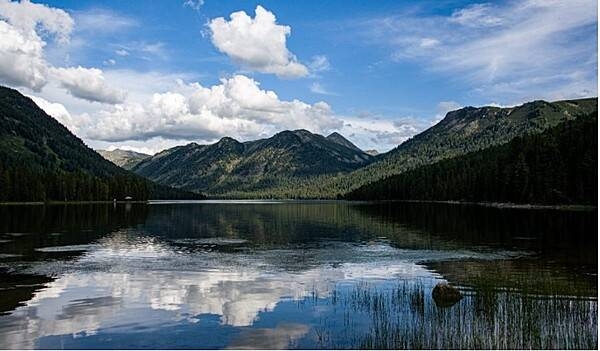Kazakhstan
Photos
12 Photos
Filter Categories
All
Filters
Measured by surface area, the Caspian Sea is the world's largest inland water body. It covers roughly 371,000 sq km (143,200 sq mi) and borders five countries. To the ancient Greeks and Persians, the lake's immense size suggested it was an ocean, hence its name. A large expanse of clear sky permitted this natural-color satellite image of the entire water body. The color of the Caspian Sea darkens from north to south, thanks to changes in depth and perhaps sediment and other runoff. The northern part of the lake is just 5 to 6 m (16 to 20 ft) deep. The southern end, however, plunges more than 1,000 m (3,300 ft). Just as the lake reaches a greater depth in the south, the nearby land reaches a greater height. The mountains of northern Iran line the southern end of the giant lake, and emerald green vegetation clings to those mountain slopes. In marked contrast to the mountains, sand seas line the southeastern and northern perimeters of the lake, and marshes occur along the lake shores in Azerbaijan to the west. Multiple rivers empty into the Caspian Sea, the Volga being the largest. Lacking an outlet, the Caspian Sea loses water only by evaporation, leading to the accumulation of salt. Although a lake, the Caspian is not a freshwater lake; the water delivered by the Volga River minimizes the lake's salt content at the northern end, but the Caspian grows more saline to the south. Kara-Bogaz-Gol is a saline inlet along the lake's eastern perimeter. Image courtesy of NASA.

The intricate lines angling and criss-crossing over the landscape are roads in extreme southwestern Kazakhstan. The turquoise areas on the left of this false-color satellite image are salt flats and marshes, some parts of which are submerged (dark blue). The body of water is Sor Kaydak, which was once a gulf of the Caspian Sea. As water levels have dropped, curious patterns in the landscape have emerged that reveal old tributaries. Image courtesy of USGS.
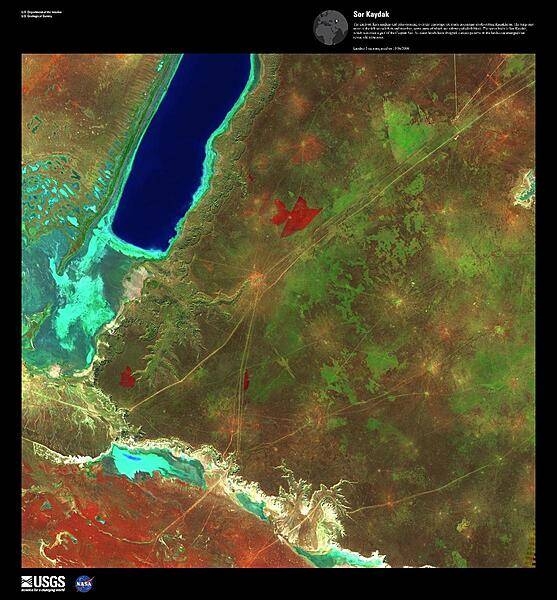
The Aral Sea, on the border between Kazakhstan and Uzbekistan, has diminished dramatically since the 1950s when its water was diverted for unfettered irrigation. By 2000, when this photo was taken, the surface area of the Aral had decreased by about two-thirds, and its volume by more than 80 percent. Today, only three lakes remain (covering less than 10 percent of the former surface area) and only one of these, the North Aral Sea (the deep blue area toward the bottom), has been partially restored. Image courtesy of NASA.
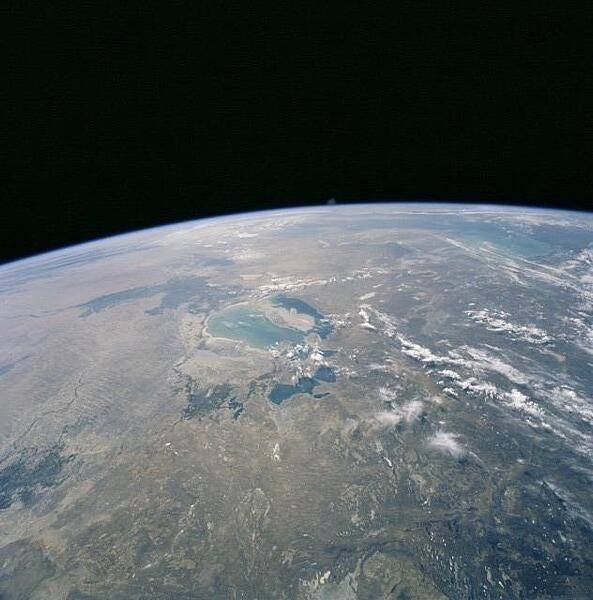
Throughout the first half of the 20th century, the Aral Sea was the world's fourth-largest lake. In the 1960s, the Soviet Union began a massive irrigation project in what are now Kazakhstan, Uzbekistan, and Turkmenistan, diverting water from the rivers that feed the Aral Sea to irrigate farmland. As its water levels dropped, the lake began splitting into smaller pieces: the Northern (Small) Aral Sea and the Southern (Large) Aral Sea. The Southern Aral Sea further split into eastern and western lobes. In August 2009 when this photo was taken, the Northern Aral Sea (upper right) still appeared healthy, the Southern Aral Sea consisted of two isolated water bodies: an irregular oval shape directly southwest of the Northern Aral Sea, and the long, thin remainder of the Southern Aral Sea's far western lobe. Much of what finally doomed the Southern Aral Sea was an attempt to save its neighbor to the north. In 2005, Kazakhstan built the Kok-Aral Dam between the lake's northern and southern portions to preserve water levels in the north. The Northern Aral Sea actually exceeded expectations with the speed of its recovery, but the dam ended prospects for a recovery of the Southern Aral Sea, which some authorities already regarded as beyond help. Lake sediments from this depleted water body have provided ample material for frequent dust storms. Image courtesy of NASA.
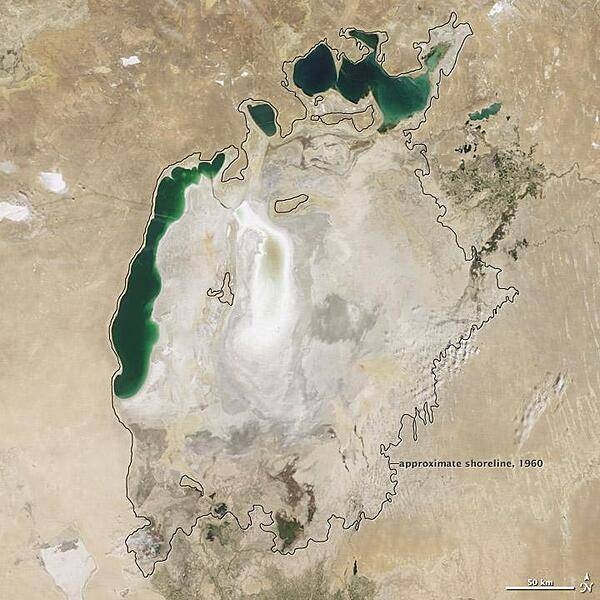
Mimicking a cubist collage, linear windbreaks of densely planted trees surround farmsteads in this winter landscape near the city of Komsomolets in northern Kazakhstan. Image courtesy of USGS.
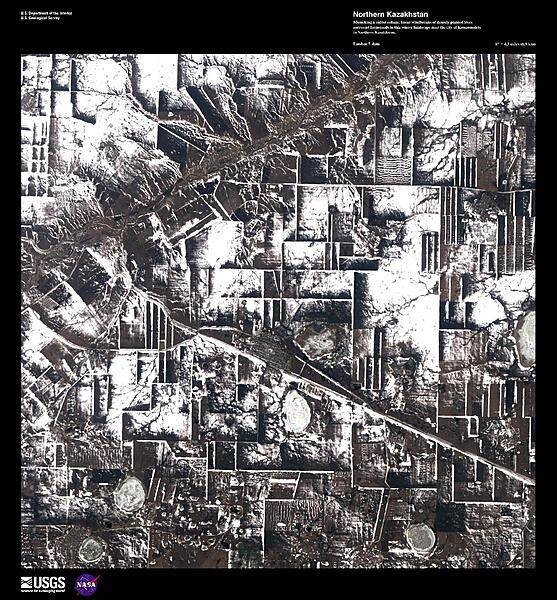
Central Asia's most important cotton-growing region is concentrated in the floodplain of the Syr Darya. The floodplain is shown here as a tangle of twisting meanders and loops (image center). The darkest areas are brushy vegetation along the present course (filled with blue-green water); wisps of vegetation are also visible along flanking swampy depressions, or sloughs. An older floodplain appears as more diffuse dark vegetation (image upper left), where relict bends are overlain by a rectangular pattern of cotton fields. The straight channel of a new diversion canal can be seen along the east bank of the river. Half the river flow is controlled from reservoirs, and half from direct water take-off from canals. In contrast to the intensive agricultural use of water shown here, water control in the mountain valleys upstream is oriented more toward power generation.
The river flows for 2,200 km (1,370 mi), from the Tien Shan Mountains west and northwest to the Aral Sea. Control of the river is vested in the Syr Darya Basin Water Organization, run by nations with territory in the watershed. Some of the organization's main efforts include accurate gauging of water use and repair of canals to reduce widespread water leakage. Photo courtesy of NASA.
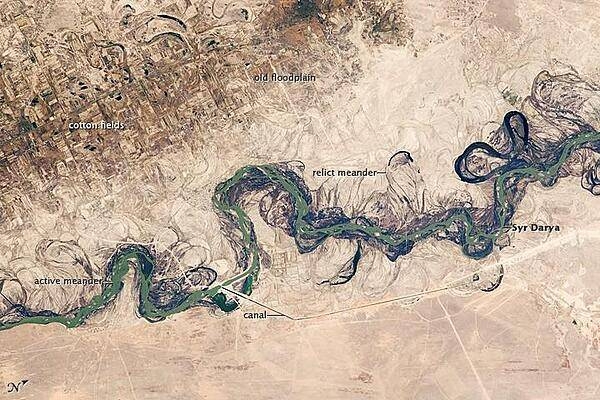
Big Almaty Lake is a natural alpine reservoir located in the Trans-Ili Alatau Mountains, 15 km south of Almaty in Kazakhstan. The lake is 1.6 km in length, up to 1 km in width, and between 30-40 m deep. The lake flows into the Big Almaty River and is part of the Ile-Alatau National Park. Depending on the time of the year, the color of the lake changes from light green to turquoise blue. The lake is the main water source for the residents of Almaty.
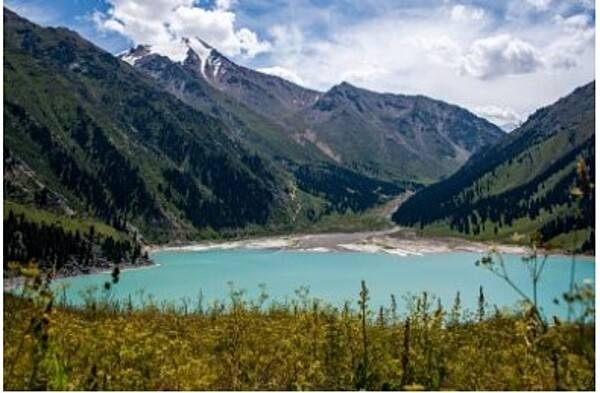
Aerial view of Almaty. Almaty, formerly known as Alma-Ata and Verny, is the largest, most populated city in Kazakhstan. It served as capital of the Kazakh Soviet Socialist Republic and later independent Kazakhstan from 1929 to 1997. Almaty is still a major commercial and cultural center; it is located in the mountainous area of southern Kazakhstan near the border with Kyrgyzstan in the foothills of the Trans-Ili Alatau. Almaty has a humid continental climate with hot summers and cold winters.
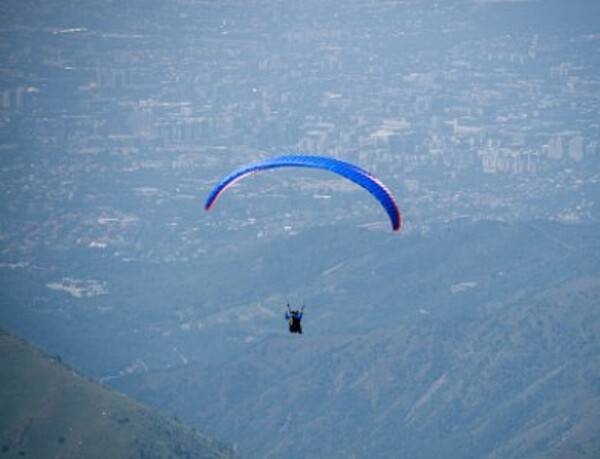
Located in the capital city of Astana on the left bank of the Esil (Ishim) River, the Akorda Presidential Palace is the official workplace of the president of Kazakhstan. Built between 2001 and 2004, it is meant to visually symbolize the traditions of the Great Steppes, Eurasian culture, and a strong Kazakhstan.
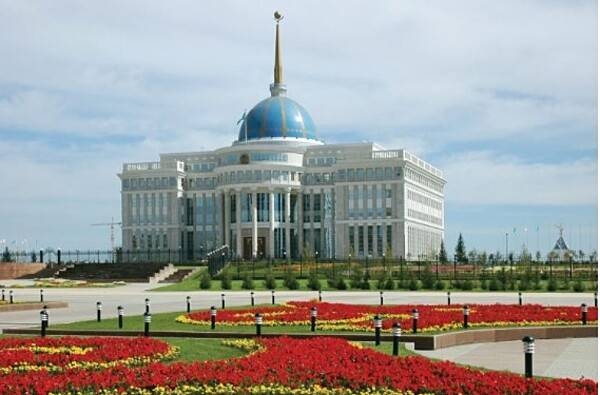
The Hazrat Sultan (Holy Sultan) Mosque in Astana is the largest mosque in Central Asia. Built on the bank of the Esil River, the building was constructed between 2009 and 2012 in the classic Islamic style using traditional Kazakh ornaments. At 110,000 sq m (11 hectares; 27 acres), the mosque can accommodate up to ten thousand worshipers.
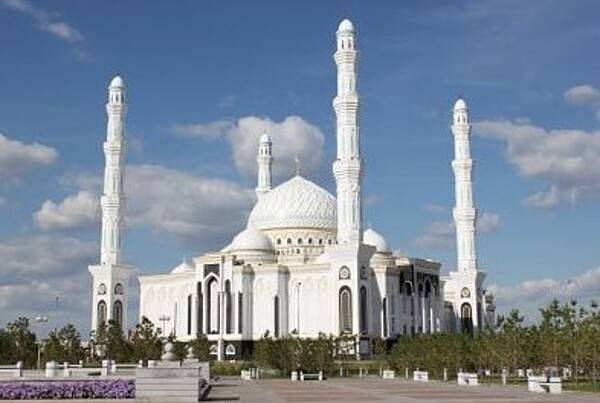
Khan Shatyr (Royal Marquee) is a transparent tent located in the capital city of Astana. Designed in a neofuturist style, the architectural project was constructed between 2006 and 2010. The 90 m (300 ft) high tent covers 140,000 sq m (14 ha; 35 acres). Beneath the canopy, which covers an area larger than 10 football stadiums, is an urban-scale park, a shopping and entertainment venue with squares and cobbled streets, a boating river, a shopping center, a mini-golf center, and an indoor beach resort. The transparent material allows sunlight into the area, moderating its temperature year round.
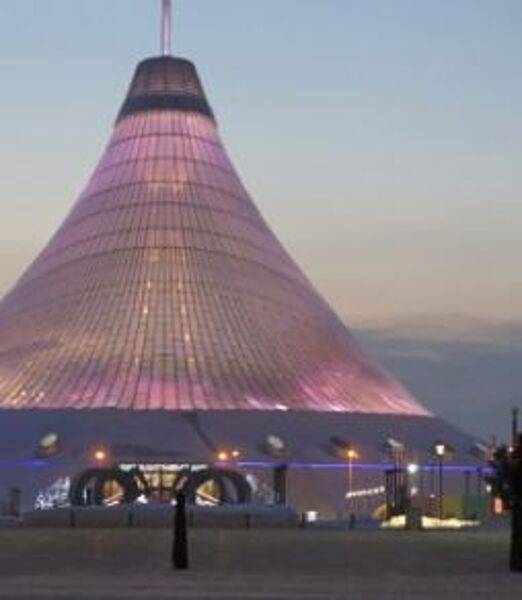
Lake Rakhmanov lies in the Altai Mountains of Eastern Kazakhstan. The lake's temperature is always low due to its depth, location, and its ice-cold tributaries. The lake is nearby Rakhman Springs in Katon-Karagay National Park. The springs are fed by warm thermal waters containing radon and nitrogen, optimal for wellness visits at a nearby sanatorium.
